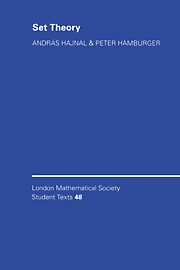Book contents
- Frontmatter
- Contents
- Preface
- Part I Introduction to set theory
- Introduction
- 1 Notation, conventions
- 2 Definition of equivalence. The concept of cardinality. The Axiom of Choice
- 3 Countable cardinal, continuum cardinal
- 4 Comparison of cardinals
- 5 Operations with sets and cardinals
- 6 Examples
- 7 Ordered Sets. Order Types. Ordinals
- 8 Properties of wellordered sets. Good sets. The ordinal operation
- 9 Transfinite induction and recursion. Some consequences of the Axiom of Choice, the Wellordering Theorem
- 10 Definition of the cardinality operation. Properties of cardinalities. The cofinality operation
- 11 Properties of the power operation
- Hints for solving problems marked with * in Part I
- Appendix. An axiomatic development of set theory
- Part II Topics in combinatorial set theory
- Bibliography
- List of symbols
- Name index
- Subject index
2 - Definition of equivalence. The concept of cardinality. The Axiom of Choice
Published online by Cambridge University Press: 10 May 2010
- Frontmatter
- Contents
- Preface
- Part I Introduction to set theory
- Introduction
- 1 Notation, conventions
- 2 Definition of equivalence. The concept of cardinality. The Axiom of Choice
- 3 Countable cardinal, continuum cardinal
- 4 Comparison of cardinals
- 5 Operations with sets and cardinals
- 6 Examples
- 7 Ordered Sets. Order Types. Ordinals
- 8 Properties of wellordered sets. Good sets. The ordinal operation
- 9 Transfinite induction and recursion. Some consequences of the Axiom of Choice, the Wellordering Theorem
- 10 Definition of the cardinality operation. Properties of cardinalities. The cofinality operation
- 11 Properties of the power operation
- Hints for solving problems marked with * in Part I
- Appendix. An axiomatic development of set theory
- Part II Topics in combinatorial set theory
- Bibliography
- List of symbols
- Name index
- Subject index
Summary
In Section 1, we enumerated all the conventions that we are going to use, with one exception. The omitted convention is the Axiom of Choice, which will be formulated in this section. Already, on the basis of our conventions so far, however, we are able to describe Cantor's key idea that led to the development of set theory. We are going to define a property called equivalence between sets. This property will express the statement that two sets have the “same number” of elements. This is the first step towards defining the concept of one set having “more” elements than another.
Definition 2.1.The state of affairs that the function f maps the set A onto the set B in a one-to-one way will be denoted as A ∼fB, and will be expressed as: A is equivalent to B according to the function f. The sets A and B will be called equivalent if there is a function f for which A ∼f B. In symbols: A ∼ B. If A is not equivalent to B, then we will write A ≁ B.
Sets equivalent to each other will be regarded as having the “same size.” This is justified in view of the following.
Theorem 2.1.The property ∼ is an equivalence property that is, it satisfies the following three conditions:
If A, B, C are arbitrary sets then
A ∼ A, that is, ∼ is reflexive;
if A ∼ B then B ∼ A, that is, ∼ is symmetric;
if A ∼ B and B ∼ C then A ∼ C, that is, ∼ is transitive.
- Type
- Chapter
- Information
- Set Theory , pp. 11 - 14Publisher: Cambridge University PressPrint publication year: 1999



